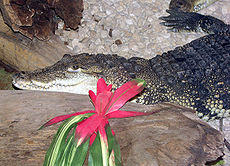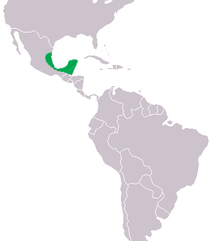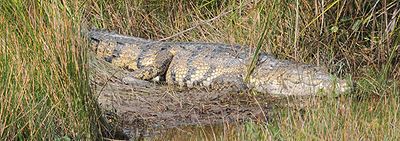- Morelet's crocodile
-
Morelet's Crocodile 
Morelet's crocodile at Cotswold Wildlife Park Conservation status Scientific classification Kingdom: Animalia Phylum: Chordata Class: Reptilia Order: Crocodilia Family: Crocodylidae Subfamily: Crocodylinae Genus: Crocodylus Species: C. moreletii Binomial name Crocodylus moreletii 
Range of Crocodylus moreletii Morelet's crocodile, also known as the Mexican crocodile, is a modest sized crocodilian found only in fresh waters of the Atlantic regions of Mexico, Belize and Guatemala.[1] It usually grows to about 3 metres (9.8 ft) in length. It is an endangered species.
Contents
History
Morelet's crocodile was discovered in Mexico in 1850[2] and named after the French naturalist who made the discovery, P.M.A. Morelet (1809–1892).[2] It was long confused with the Cuban crocodile and the American crocodile because of similar characteristics shared between species. It was not realized that they were an entirely different species until the 1920s.[3] Present day crocodilians come from an ancient lineage comprising over 125 genera.[4]
Appearance
The Central American crocodile is known as the Morelet’s crocodile or the “Mexican crocodile.” It is small in size compared to some other crocodiles. The males can become larger than the females; this is known as sexual dimorphism.[3] This crocodile can reach lengths around 3 metres (9.8 ft) to 4.3 metres (14 ft) as adults[5] and is similar to the American and Cuban crocodiles in appearance.
There are features of this species that set it apart and make it easy to identify. It has a very broad snout[3] with 66 to 68 teeth when they are fully matured.[2] Crocodiles can be distinguished from alligators because of their teeth in both their upper and lower jaws. Their teeth in both jaws are perfectly aligned.[3] The fourth tooth on the bottom jaw of the crocodile is visible when their jaw is closed because it is slightly bigger than the rest of its teeth.[3]
The nostrils are located in front of the snout, then directly behind them are the eyes, followed by the ears [3] and all three are on top of the crocodiles head. When almost fully submerged, it still has the capability to smell, hear, and see its surroundings.[3] Crocodiles can see under water due to their nictitating membrane which surrounds their eye.[3] This is a clear eyelid which can protect the crocodile’s eyes and allow it to see as well.[3]
Morelet's crocodiles are a dark grayish-brown color.[2] They have dark bands and spots on the body and the tail.[2] This is similar to other crocodiles like the American crocodile, but the Morelet is somewhat darker.[2] Juvenile crocodiles are bright yellow in color with some dark bands.[3] The crocodile’s iris is silvery brown in color.[2] They have 2 legs and 2 arms along with a long tail which is used for swimming. The hind feet of crocodiles are webbed. Crocodile legs are short so the crocodiles are located very close to the ground. They have very explosive capabilities because of their strong muscles and are fast runners.
Habitat
Morelet's crocodile can be found in freshwater habitats in Central America[2] and along the Gulf of Mexico stretching through Belize, Guatemala, and to Mexico.[2][4] In their freshwater habitats they prefer isolated areas that are secluded. This species of crocodile can be largely found in freshwater swamps and marshes[2] which are located inland, and in large rivers and lakes.[6] Both of these habitats are forested to help add cover.[2]
The Morelet can also be found along the coast in brackish waters.[3] Brackish waters are areas where the salt water from the ocean mixes along with the freshwater from the inlands.[3] In these areas the habitat is slightly different than the freshwater forested swamps inland. They also inhabit the grassy savannas on the Yucatán Peninsula.[7] These crocodiles become much more distributed during the rainy seasons when flooding occurs and it is easier for them to move elsewhere.[7] Juvenile crocodiles live in very dense cover to protect them from other predators that might be in the area and will remain there until they become older and able to fend for themselves.[2] The adult crocodiles are known to dig out burrows during times associated with the dry seasons in their area.[2] The range of this crocodile can overlap with the American crocodile, which can sometimes lead to them being confused with one another.[3]
Diet
Crocodiles are carnivores. They capture their prey with stealth like techniques, slowing sneaking up on their prey. When a crocodile captures its prey they must first kill it before eating. Crocodiles kill the majority of their prey by grasping them in their muscular jaws and dragging their prey back into the water to drown.
Crocodiles feed largely on fish and insects.[6] This is the diet of the majority of the juvenile crocodiles until they become bigger and more capable of bringing down larger prey. Crocodiles will prey on small mammals, birds, and even other reptiles.[5] These small mammals can include domesticated animals like cats and dogs as well as other wild animals.[3] Crocodiles have been known to be cannibalistic,[3] this includes eating their young.
Breeding
Breeding usually talks place between April and June[7] and the eggs or laid before the start of the rainy season.[2] Morelet's crocodiles are unique among North American crocodiles in that they build mound nests only, and not mound and hole nests.[3] These mound nests are about 3 metres (9.8 ft) wide and 1 metre (3.3 ft) high[2] and can be found near the water or on floating vegetation.[2][3] A female crocodile can lay between 20 and 45 eggs[2] and nests have been found containing eggs from more than one female.[2] The eggs are buried and the nests are guarded by females that protect their unborn young from predators.[2] The eggs usually hatch after 80 days of incubation[7] and hatchlings are normally about 17 centimetres (6.7 in) long.[1] After the eggs have hatched the female crocodile will carry her young to the water where they are protected by both parents[2] and will later leave them to fend for themselves.
Threats
The Morelet's crocodile has long been threatened by habitat destruction and illegal hunting.[8] Both of these factors have significantly lowered their populations. It was hunted for its hide during the 1940s and 1950s[8] because high quality leather can be made from their skins.[9] Crocodile leather can be used to make wallets, coats and shoes.
Conservation
The Morelet’s crocodile is an endangered species.[7] One of the key protectors of crocodiles today is the CSG, or Crocodile Specialist Group,[10] started in 1971.[10] This is a worldwide organization of biologist and other professions coming together to conserve the 23 species of alligators and crocodiles. The CSG monitor all trading of crocodile skins.[10] They help determine if the skins are legal or if they were illegally taken. When this organization started all of the crocodilian species were either threatened or endangered.[10] Today those numbers have greatly changed.
“By 1996 one third of the crocodilian species were abundant enough to support regulated annual harvests, another third were no longer in danger of extinction, but the final one third of the species still remain endangered.”[10]
See also
Britton, Adam. "How Long Do Crocodiles Live for?" Crocodilian Conservation Database. 2002. <http://www.flmnh.ufl.edu/cnhc/cbd-faq-q3.htm>.
References
- ^ a b "Crocodilians species (CSG)". http://iucncsg.org/ph1/modules/Crocodilians/species.html#cm.
- ^ a b c d e f g h i j k l m n o p q r s t Britton, Adam.. ""Crocodylus Moreletii." Crocodilians Natural History and Conservation. 2002.". http://www.flmnh.ufl.edu/cnhc/csp_cmor.htm.
- ^ a b c d e f g h i j k l m n o p q ""Morelet's Crocodile." Angel Fire. 15 May 2003.". http://www.angelfire.com/mo2/animals1/crocodile/morelet.html.
- ^ a b Dever, J. A; Richard E. Strauss, Thomas R. Rainwater, Scott T. McMurry, and Llewellyn D. Densmore III. “Genetic Diversity, Population Subdivision, and Gene Flow in Morelet’s Crocodile (Crocodylus moreletii) from Belize, Central America” Copeia. 2002. 4: 1078-1091.
- ^ a b ""Morelet's Crocodile." Belize Zoo. 2007.". http://www.belizezoo.org/zoo/zoo/herps/cro/cro1.html.
- ^ a b ""Freshwater Crocodile." Australia Zoo.". http://www.australiazoo.com.au/our-animals/amazing-animals/reptiles/?reptile=crocodilians&animal=freshwater_crocodile#Mr%20Freshy.
- ^ a b c d e Navarro, Carlos.. ""The Return of the Morelet’s Crocodile." Reptilia." (pdf). http://www.reptilia.net/articulos_ing/036.pdf.
- ^ a b ""Crocodylus Moreletii." Florida Museum.". http://www.flmnh.ufl.edu/natsci/herpetology/act-plan/cmore.htm.
- ^ Platt, Steven; John Thorbjarnarson. “Population status and conservation of Morelet’s Crocodile, Crocodylus moreletii, in northern Belize” Biological Conservation. 2000. 96: 21-29.
- ^ a b c d e King, F. ""The Crocodile Specialist Group." Crocodile Specialist Group. 4 Mar. 2002.". http://www.flmnh.ufl.edu/herpetology/Crocs.htm.
Extant Crocodilian species Kingdom: Animalia · Phylum: Chordata · Class: Sauropsida · (unranked): Archosauria · Superorder: Crocodylomorpha Family Gavialidae Family Alligatoridae Alligatorinae
(Alligators)Caimaninae
(Caimans)Categories:- IUCN Red List conservation dependent species
- Crocodilians
- Crocodylidae
- Reptiles of Mexico
- Reptiles of Belize
- Reptiles of Guatemala
Wikimedia Foundation. 2010.




